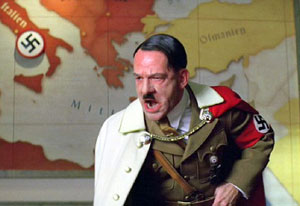
(Warning: Entering Spoilerville. Those who have not yet seen Quentin Tarantino's Inglourious Basterds will find plot details revealed. Abandon proper spelling, all ye who enter here.)
Day of the Jackal ranks among my favourite '70s films. Fred Zinneman's 1973 adaptation of the Frederick Forsyth thriller tells of a plot to kill French President Charles de Gaulle, a daring narrative approach since the audience (at least those who had studied France in high school) knows that De Gaulle was never assassinated. The suspense lies in how the plot will be thwarted.
Or so audiences assume. Now imagine Day of the Jackal remade by Quentin Tarantino, and entirely new narrative possibilities open up. The Jackal puts a bullet clean through De Gaulle's forehead and flees over the rooftops. In the sequels he bumps off Brezhnev and, by popular demand, Nixon. Why not? It's the movies.
That's a point Tarantino makes rather forcefully in his latest, the World War II potboiler Inglourious Basterds. A plot to kill top Nazi brass at a movie premiere kicks up a notch when Hitler himself falls into the trap. Assumptions that would apply to other films must be put aside here -- Tarantino's gleeful willingness to create alternate historical realities results in a bullet-ridden Fuhrer who is then blown up and, for good measure, burned. That last part actually happened, at least.
Tarantino's point is legitimate. Movies can do whatever they want. The filmmaker's only yardstick is whether it works for the film. But the questions raised by that anything-goes approach are both cultural and artistic. Do movie makers have any responsibility beyond entertainment? And for that matter, is the "anything goes" approach even a good film-making strategy?
CGI abuse
"Anything goes" is an approach that extends beyond historical accuracy. Thanks to computer generated imagery, movies can create scenes never before possible. Unfortunately, making CGI scenes technically possible does not necessarily make them remotely plausible. CGI abuse has led to the current and very tedious state of affairs wherein imperiled heroes merely suspend the laws of physics to escape their predicaments time and again. The only mystery left is why anyone cares.
New universes are fine as long as they stick to their own logic. The late Barry Beyerstein of the Skeptical Inquirer once told me that, were he a character in the fictional world of The X-Files, he would believe in alien abductions too. Within the context of the series you'd be a fool to believe otherwise. One of my favourite movies is 1991's The Rapture, which takes the fundamentalist ideology of the End Times as stated, and then plays it out to better examine the philosophy and theology of it all. It's a simple and brilliant use of the power of film -- creating an alternate reality to explore the implications of conservative Christian belief.
But the issues of history in cinema are a different matter. The problem comes when the line between reality and alternate reality is not so clear as in Inglourious Basterds. Tarantino has never revealed his reasons for the weird spelling of the title, but I suspect it's a sign to check your sense of reality at the door. Certainly most people (let us hope) understand that Hitler wasn't machine-gunned in a movie theatre. But when films dramatize historical moments with which audiences are less familiar, the results can create pernicious historical myths. Roland Emmerich's execrable 2000 film The Patriot actually took a Second World War Nazi atrocity, the annihilation of the Czech village of Lidice, and transposed it to the American Revolutionary War, implying that the British were guilty of Nazi-style mass civilian murder. It's cheap pandering, and it leaves a scar. Hollywood has every right to do it. But harmless fun it ain't.
Quentin's glorious ego
Clearly the Tarantino philosophy is, "Above all, to one's own self be true." A film maker's job is to make the internal logic work onscreen. In fact, the biggest complaint you can make about Tarantino's climactic scenes is not so much historical inaccuracy but cinematic inconsistency. Tarantino has said he wanted Inglourious Basterds to have the feel of a spaghetti Western. And yet for most of the movie's length he succeeds in creating a very watchable and involving war flick. The real problem with the climax is how he decides to leave us behind in the trenches as he goes charging over the top.
Audiences for Inglourious Basterds must also reckon with the Tarantino Ego. Quentin loves the distinctive flourish. Although he does not give himself an onscreen role here (except, briefly, his hands and voice), some of his artistic choices are the equivalent of cameo appearances. The use of the 80s-era movie theme, "Cat People (Putting Out Fire)" by David Bowie is certainly an interesting jolt. But for those familiar with his work the director might just as well have jumped onscreen shouting, "Here I am!"
Even the surprise dispatching of the little Viennese corporal speaks of Tarantino's considerable self-regard. Let the other pikers stick to facts, Tarantino seems to be saying -- in my movie, I decide when Hitler bites the dust.
Still, he gets points for audacity and, as always, plenty for style. And I'll take a dead Hitler over Ben Affleck kicking ass at Pearl Harbour.
Bonus review: 'Whiteout'
New this week: Remember how Body Heat made everyone look sweltering hot? Whiteout is a movie set in the Antarctic where nobody looks cold. Kate Beckinsale plays U.S. Marshall Carrie Stetko, stationed way, way down under. Director Domenic Sena establishes her character immediately by having her undress and get into the shower. Plucky Carrie sets out to solve the ultimate cold case while, amazingly, never getting frost in her hair. Throw in a hidden villain so obvious that the entire audience could shout the name in unison and you have a movie that is a couple of ice layers below perfunctory. My neighbour at the preview screening opined: "It was OK for free." I'd knock about one-and-a-half stars off that review. ![]()
Read more: Film















Tyee Commenting Guidelines
Comments that violate guidelines risk being deleted, and violations may result in a temporary or permanent user ban. Maintain the spirit of good conversation to stay in the discussion.
*Please note The Tyee is not a forum for spreading misinformation about COVID-19, denying its existence or minimizing its risk to public health.
Do:
Do not: